Introduction
Of the approximately 70 different sleeping bags I’ve used, the Patagonia 850 Down 19 Degree is the most comfortable all-purpose mummy bag for use above freezing.
Based on specifications alone, the backpacker interested in saving the most amount of weight on a sleeping bag may pass over the Patagonia 19 Degree bag unless a high priority is placed on features that add to user comfort, like a center zip or roomy interior, or durable fabrics.
The Patagonia 19 Degree down bag would also be a great choice for three-season car camping, backcountry base-camping (where you spend a small portion of the trip carrying the bag), and for alpinists or winter hikers who sleep wearing a down parka and insulated pants. I do not recommend this sleeping bag if your primary use is long-distance backpacking where weight-savings is critical.
However, if you want a sleeping bag that’s very comfortable, versatile across a wide range of activities as described above, and light enough for occasional backpacking trips, the 19 Degree is worth considering.
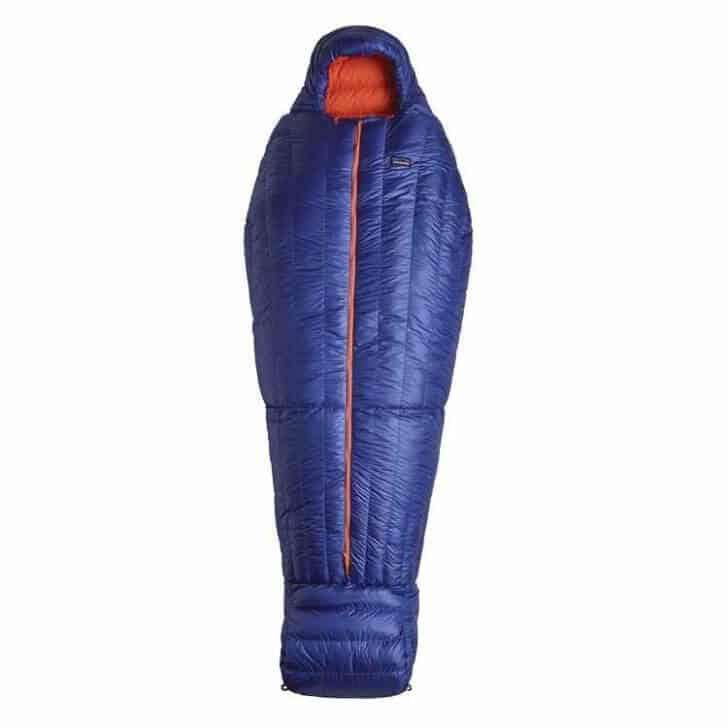
The Patagonia 19 Degree down sleeping bag was designed for alpinists. It has an extra large foot box for sleeping with climbing boots on, a center zipper that makes using your arms easier when sitting up, an extra wide cut for wearing insulated pants and a parka, and an interior fabric that’s more durable than the exterior fabric – in case a boot lace hook snags on the fabric.
I tested this bag over the course of nine weeks of backcountry travel, and used it side-by-side with three other top models (see below for a comparison table).
I adore the comfort of the Patagonia 19 Degree but found that it is not as warm as other bags that weigh the same amount.
Three primary attributes affect its performance-to-weight ratio: less loft, extra wide cut, and the omission of an adjustable neck baffle. Unless you have a large chest (perhaps men’s XL) or are wearing a down parka, or simply appreciate some room inside of your mummy bag, the Patagonia 19 Degree down bag may be too wide for you.
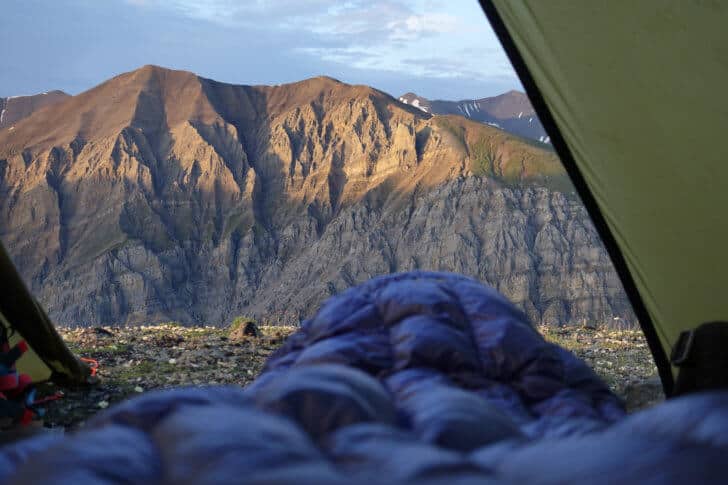
Features and Specifications
- 32.9 oz (933 g) in size Regular;
- Box-baffle construction with 850-fill down;
- Extra large foot box for sleeping with climbing boots on;
- Extra wide torso for sleeping with a down parka and pants;
- 1.2 oz/yd2 (40.7 g/m2) 15-denier nylon interior fabric is stronger and more durable than the exterior fabric (0.85 oz/yd2 or 28.8 g/m2 15-denier nylon) for wearing climbing boots and a harness inside the bag;
- Interior fabric is soft against the skin and especially comfortable for sleeping naked;
- Three zippers for venting and sleeping with a climbing harness tied to an anchor.
Review Context
I am passionate about sleeping bags because having the best one for a specific application can save a lot of weight and helps me sleep well. I have found that sleeping bags are one of the most important gear items to dial in when doing a trip that’s physically challenging, because of the performance and weight differences across the range of sleeping bag designs. Making the right choice for a sleeping bag is important to me so I can get a good night’s sleep that helps my body recover during physically demanding expeditions.
My research question for testing this sleeping bag was: “Is the Patagonia 19 Degree sleeping bag the best all-purpose three-season sleeping bag on the market?”
Field Testing & Research
I used this bag for eight weeks of backpacking and camping in Wrangell St. Elias National Park, Alaska. My mother used it for a weeklong backpacking trip in southern Utah. This review also benefits from my conversations with a friend, who used it for the Alaska Wilderness Ski Classic (AWSC), a 200-mile ski race in the Arctic (note: most people bring -20 F (-29 C) sleeping bags for the AWSC, not a three-season bag).
I interviewed Casey Shaw, Manager of Advanced Research and Development at Patagonia, who helped design this sleeping bag, to learn more about its unique baffle construction and his rationale for certain design elements. Also, I am fortunate to have a collection of what I believe are some of the world’s best sleeping bags, which made it easy to compare this bag to others.
The bags I personally own are: Feathered Friends Lark UL 10, Katabatic Gear Palisade, Katabatic Gear Grenadier, Nunatak Gamut 20, Feathered Friends Spoonbill, Feathered Friends Penguin 20 + Groundsheet, ZPacks Twin Quilt, and Western Mountaineering Puma GWS -25. Therefore, this review of the Patagonia 19 Degree down bag should be considered in context with my experience with these bags.
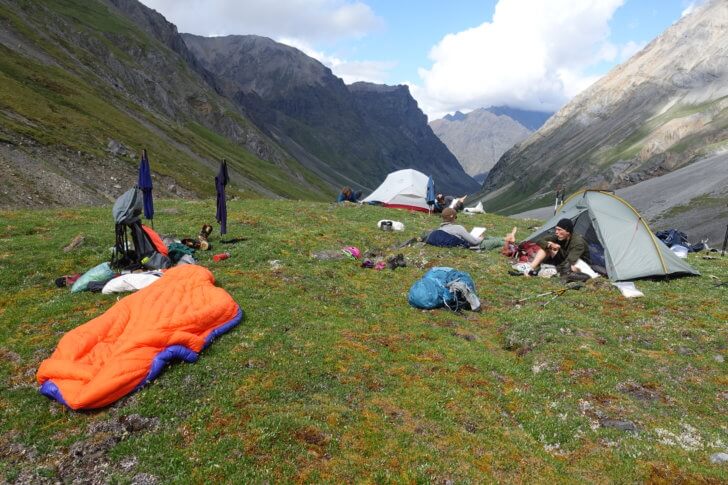
Performance Assessment
Warmth
Everyone I know who has used this bag wishes it were warmer for its weight.
Based on my field experience with four similarly-spec’d bags (including the Patagonia 19 Degree), I assigned my own effective temperature rating to each bag – that temperature below which I usually found myself uncomfortably cool without wearing clothing. That effective comfort rating is noted in the table below.
These comfort ratings are significantly lower that the manufacturer’s bag rating. Keep in mind that I’ve assigned them based on field conditions, wearing no clothing, and the fact that my body type is relatively thin (so there’s a bit of extra interior room to warm up).
As you can see in the table, other sleeping bags that weigh the same amount are somewhat warmer. I only recommend the 19 Degree bag for use down to the 40s F (4.5 C to 10 C). As soon as temperatures drop lower, I needed to wear more clothing and ended up wishing I was inside one of my other sleeping bags. However, this bag is incredibly comfortable for use in warmer weather and could be worth considering, if comfort in camp is more important than saving weight. See the Comfort section below to learn more.
The table below compares the 19 Degree bag to three close competitors – the Katabatic Gear Grenadier 5, the Feathered Friends Lark UL 10, and the Western Mountaineering Versalite 10.
Scroll right as needed to view entire table.
| Name | Weight (oz) | Fill Power (cu. in./oz) | Fill Weight (oz) | Fill Volume (cu. in.) | Shoulder Girth (in) | Waist Girth (in) | Foot Girth (in) | Loft (in) | Effective Comfort Rating (deg F) |
|---|---|---|---|---|---|---|---|---|---|
| Katabatic Gear Grenadier 5 | 28.1 | 900 | 18.6 | 16,740 | 61 | 43 | 38 | 3.75 (single side) | 30 |
| Feathered Friends Lark UL 10 | 32.0 | 900 | 20.0 | 18,000 | 60 | 56 | 38 | 6.5 | 35 |
| Western Mountaineering Versalite 10 | 32.0 | 850 | 20.0 | 17,000 | 62 | 53 | 39 | 6.0 | 35 |
| Patagonia 19 | 32.9 | 850 | 19.7 | 16,745 | 60 | 57 | 41 | 5.5 | 40 |
What follows is a summary of the attributes that reduce the Patagonia 19 Degree down bag’s warmth compared to other sleeping bags in this weight class.
Less Loft
This bag has less loft compared to other sleeping bags that weigh the same amount.
The most striking example is the Katabatic Gear Grenadier quilt, which has approximately 1.5 in (3.81 cm) of additional single-sided loft than the Patagonia 19 Degree (3.75 in vs. 2.25 in)! The Feathered Friends Lark UL 10 and Western Mountaineering Versalite also have significantly more loft than the Patagonia 19 Degree bag. All of these three competing bags weigh slightly less than the 19 Degree and have more durable exterior fabrics.
Extra Wide Girth
Manufacturer-reported circumference (girth) specifications (especially at the waist and foot) are found in the table above. The photo below shows that, compared to an average mummy bag, the 19 Degree is wider from just below the shoulders all the way down to the ankles.
The extra space is beneficial for three things:
- Sprawling out. There’s lots of room for your legs. I can even sit up cross-legged, which is not possible in most bags.
- If you have a large torso. Perhaps men’s extra large?
- Wearing high-loft down pants and a down parka.
My friend Katie Strong used the Patagonia 19 Degree down bag for the 2017 and 2018 Alaska Wilderness Ski Classic races and a wide variety of backpacking and backcountry skiing adventures since then. Here’s what she said about the bag’s fit:
“I like the foot space, especially because I generally have things like a warm water bottle down in that area. I also like that there’s room to put something under my knees for body position comfort, and in the winter I’m trying to keep almost everything in my bag with me. BUT, I don’t like all the space in the upper torso area. Even with a down jacket on and all sorts of things shoved in the bag with me, it’s too wide (for me). I have to be careful so that my arms aren’t falling off my pad (and getting cold) and would prefer to be held in a bit more. I’m not sure who needs that much space, but I guess when they’re doing sizes, they only modify the length and not the girth??? I don’t actually know, but the upper torso area feels like it’s made for a very large-around person. I feel very strongly that it’s too wide in the torso. And I’m a person who struggles with claustrophobia!”

Non-adjustable neck baffle
Most 15-degree down sleeping bags have an adjustable neck baffle that seals out cold air. I have found this to be an essential feature for use below freezing. Depending on the efficacy of the hood design, it can also be beneficial for temperatures in the 40s.
The Patagonia 19 Degree down bag has an overstuffed neck baffle that wraps around the neck area. It is not as large as conventional neck baffles and, more importantly, there is no mechanism to cinch it tight around the neck. It is better than nothing, but it does not eliminate air transfer between the inside and outside of the bag.
The photos below show the neck baffles on the Patagonia 19 Degree and the Feathered Friends Lark 10 (which weighs less than the 19 Degree and is somewhat warmer).
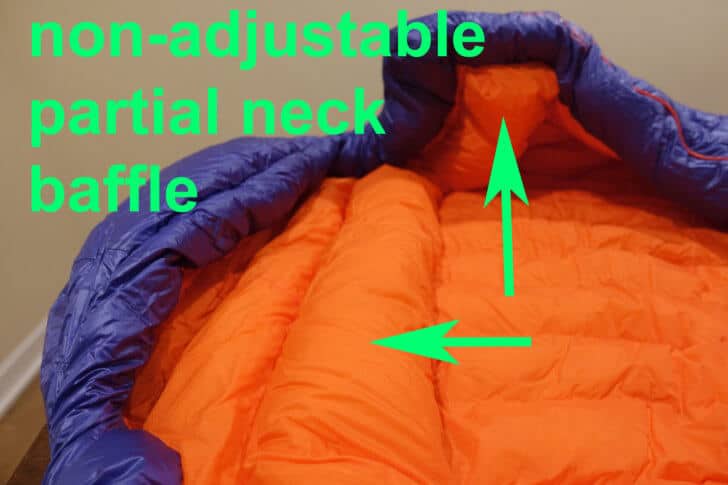
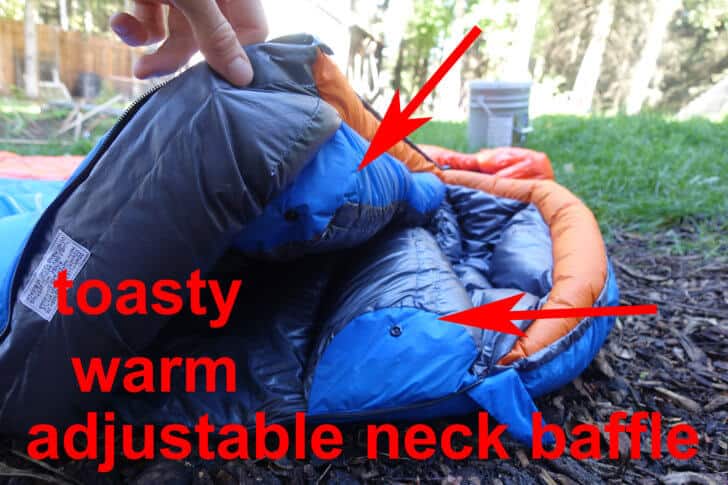
Are vertical baffles better?
I had a long conversation with Casey Shaw, Manager of Advanced Research and Development at Patagonia, about vertical baffles in sleeping bags. The key takeaway from the conversation and my experience with this bag in the field suggests that vertical baffles provide better stabilization of down. Vertical baffles also use less material than horizontal baffles. Casey “spent a day doing the math” to determine if vertical baffles are lighter than horizontal baffles and said, “they save a small amount of weight.”
Most other bags with vertical baffles use Insotect Flow, which is a mesh barrier that does not completely seal the chamber. This makes it easier to fill the bag and reduces cost, but it’s possible for down to migrate from one chamber to the other. The 19 Degree bag is segmented into three parts and has fully sealed baffles.
Weight
The 19 Degree bag weighs 32.9 oz (933 g) in size Regular (suitable for users up to about 6 ft 0 in tall). This amount is similar to other $400-$500 down mummy bags, which all have around 20 oz (567 g) of down and weigh around 32 oz (907 g).
All of the quilt-style sleeping bags I’ve used have a much higher warmth-to-weight ratio than the Patagonia 19 Degree. For example, the Katabatic Gear Sawatch is warmer than the 19 Degree (3.25 in of single-sided loft) and it only weighs 24 oz (680 g) in size regular. That’s 22% less. See the specifications table above for additional comparisons between bags of similar weight.
Comfort
This is the most comfortable mummy sleeping bag I have ever used. Hands down. No competition. The main drivers of its exceptional comfort are the extra space, center zip, extra large foot box, and the interior fabric.
Extra space
Like beds, wider sleeping bags are more comfortable than narrow sleeping bags. The Patagonia 19 Degree is one of the wider mummy bags on the market. When I’m inside the bag, touching one side, there’s an extra 8 in (20 cm) of space on the opposite side of my hip. I wear size 32 pants.
Hood
This is not your average sleeping bag hood. It is vastly more sophisticated – more like the hood on a down parka. But does it perform better? I found that it is very comfortable when wide open and when partially closed. However, it is not comfortable when cinched tightly and the lack of a neck baffle encouraged me to pull the hood tight more than I do with other bags. Overall, I prefer the hood on a traditional mummy sleeping bag.
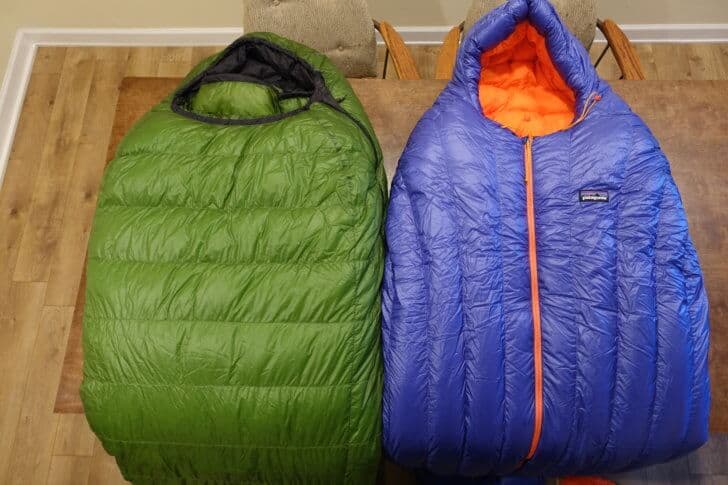
Center zip
The center zip, which is composed of three separate zipper pulls, makes it easy to use your hands while sitting up inside the bag or vent the lower leg area while the hood is open. If you’re a climber perched on a precarious ledge, you can clip into an anchor and run the rope through the bottom of the zipper, without reducing access for your hands or having the rope near your face while you’re sleeping.
Backpackers may appreciate center zips as well for tasks like cooking, sitting up, and reading. I found that reading in the bag was more comfortable because I could lay on either side and still have my shoulders and head covered. Overall, I find that the center zipper significantly increases comfort compared to traditional sleeping bags with zippers on one side.
Through all of my field testing I did not observe any significant heat loss through the zipper area, which is protected by large baffles on both sides of the zipper. Katie Strong, who has used the bag in colder temperatures than me, also reported no significant heat loss in this area.
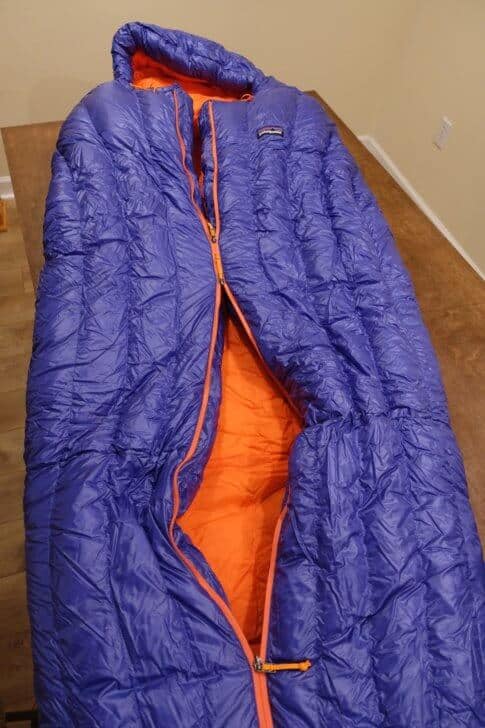
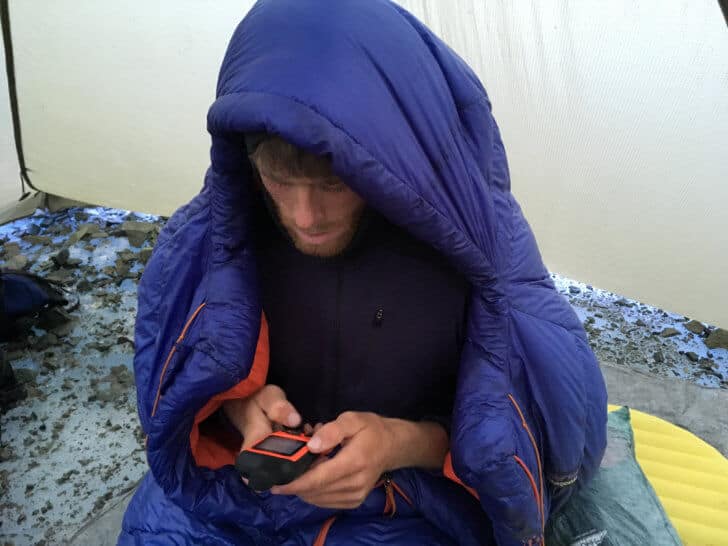
Interior fabric – great for sleeping naked
The Patagonia 19 Degree bag uses the Houdini fabric on the interior. This 15-denier fabric has a textured surface that creates friction (heat) when you slide your body over it. All other sleeping bags I’ve tested use smooth taffeta fabrics on the interior. They feel cold next-to-skin when you enter the bag. If you like to sleep naked in a sleeping bag, you might benefit from this fabric choice. Casey Shaw, the bag’s designer, told me that he loves to sleep naked.
Durability
The bag we tested for nine weeks had one substantial durability issue and two less significant issues. For the substantial issue, we sent the bag to Patagonia’s Forge (the advanced development group) for inspection. They cut it open and determined that the interior baffle stitching came undone and all of the down in that baffle escaped elsewhere! This happened after washing the bag. It’s unclear if the baffle failed during use or if it was not constructed properly at the factory. Patagonia sent a replacement bag.
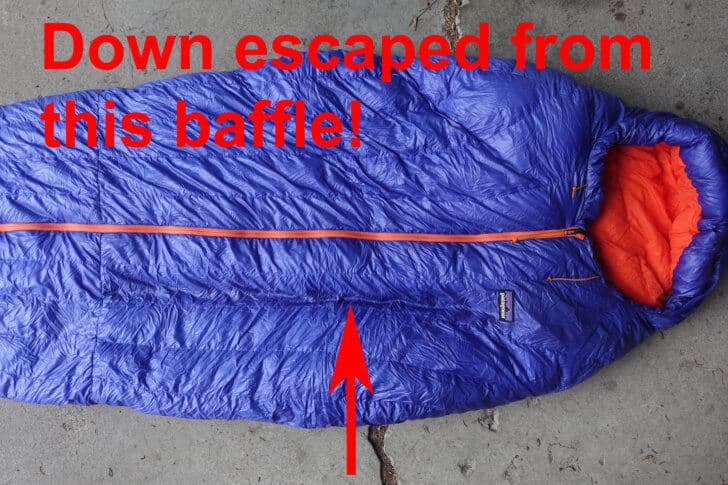
The two less significant durability issues we encountered with this bag were:
- The exterior stitching on one foot box baffle failed.
- The hood drawcord “keeper” failed.
See the photos below for details.
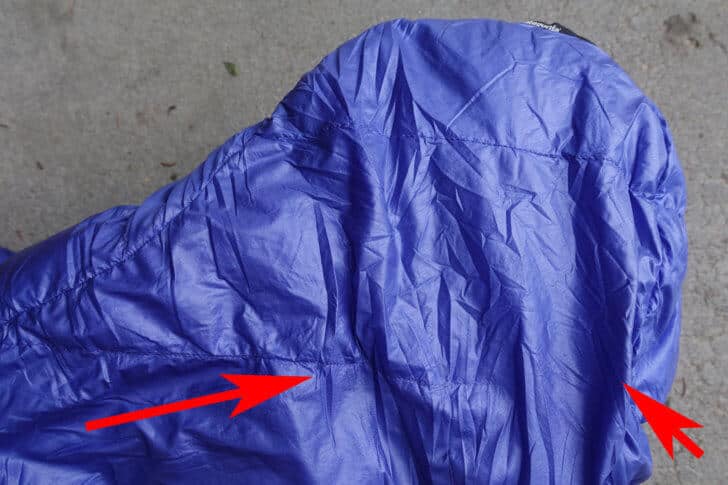

Highly durable interior fabric
The interior Houdini fabric weighs 1.2 oz/yd2 (osy) (41 g/m2). Other fabrics used in ultralight sleeping bags weigh half as much! The tear strength of the Houdini fabric is approximately two and a half times greater than the lightest fabric Patagonia uses, a 0.8 osy nylon on the Patagonia Micro Puff Hoody.
Patagonia chose a tougher and stronger fabric for the interior in case a boot lace hook snags on the fabric and because climbers sleep inside the bag with a harness on and with a fuel canister and water bottle inside the bag. I do not believe the interior fabric choice offers any significant benefit to the backpacker (with the exception of next-to-skin comfort).
Versatility
The primary attribute that makes a sleeping bag versatile (able to be used across a wide range of conditions) is its girth. Bags with adjustable girths, such as all quilt-style sleeping bags, can adapt to different body sizes and different amounts of clothing.The Patagonia 19 Degree is versatile in the sense that is has a large girth and can, for most people, accommodate a significant amount of insulated clothing without reducing the loft of either the bag or the clothing.
The Patagonia 19 Degree also has a versatile amount of insulation that strikes a good balance between both warm and cool conditions. Overall, for a hooded mummy bag, this bag ranks above average for versatility. If it were warmer, it would rank near or at the top.
Strengths and Limitations
Strengths
- The extra space and soft next-to-skin fabric make the bag very comfortable.
- The center zip is more comfortable than a side zip and has significant advantages for technical climbers. For backpackers, the center zip offers some usefulness because the bag can be draped over your head for activities that involve sitting up.
- The foot box is large enough for sleeping with boots on or storing a fuel canister and hot water bottle. Backpackers may appreciate the wider girth for contorting into more comfortable lower body sleeping positions.
- Due to its high tear strength, the interior fabric is well suited to sleeping with boots on or perhaps cuddling with a small dog.
Limitations
- The girth is too wide unless you appreciate the extra room, have a large chest (perhaps men’s XL), or are wearing a down parka.
- Its relatively low warmth-to-weight ratio – a result of its wide cut and heavier fabrics.
- Cold air enters through the neck opening because there is no adjustable neck baffle.
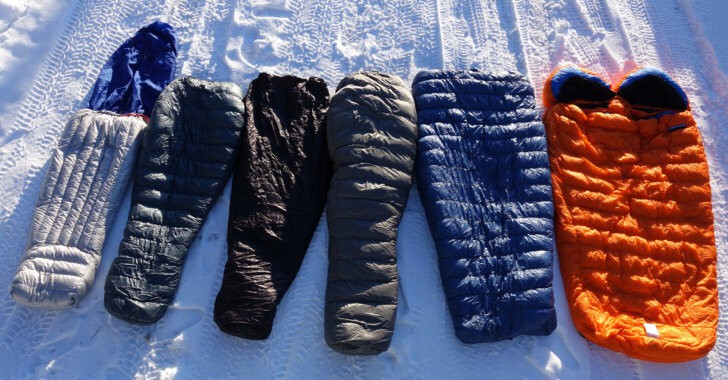
Compared To
Feathered Friends Lark UL 10
This is my personal favorite all-purpose mummy sleeping bag due to its high warmth-to-weight ratio and its ability to keep me comfortable below freezing.
- Learn more about the Feathered Friends Lark UL 10
Western Mountaineering Versalite
This is very similar to the Lark UL 10 in that it is warmer, and warmer for its weight than the Patagonia 19 Degree bag. I prefer the Lark’s hood and neck baffle closure system, which has snaps instead of velcro.
- Learn more about the Western Mountaineering Versalite
Katabatic Gear Grenadier
This is my personal all-time favorite one-person sleeping bag because it is shockingly warm for its weight. I have used this extensively for winter trips where saving weight is the top priority, and it also vents well for use in summer. If I were to have just one sleeping bag (for my trips mostly in Alaska), I’d choose this one. It is warm enough for winter, lightweight, and highly versatile.
- Learn more about the Katabatic Gear Grenadier
REI Co-op Magma 10
I haven’t used this bag, but the research I’ve done suggests it is a very good value. $350! Ryan Jordan has used this bag extensively and has positive things to say about it in his Publisher’s Gear Guide. In addition, it was featured in the 2017 Backpacking Light Staff Picks by Backpacking Light Wilderness Adventures Director Kevin Fletcher.
- Learn more about the REI Co-Op Magma 10
Review Rating: Above Average / Recommended
Above Average: Compared to all three-season down mummy bags available, the Patagonia 19 Degree is above average because it is more comfortable. However, I do not recommend this sleeping bag for “ultralight backpacking” per se – there are plenty of other options that are warmer for the weight, including quilts.

Recommended: I do recommend the Patagonia 19 Degree bag if one or more of the following is true: (1) you have a large torso; (2) you want a bag with extra space for more comfort: (3) you are an alpinist and intend to sleep with your climbing boots on inside the sleeping bag; (4) you are looking to purchase one mummy bag that’s large enough to wear insulated pants and a down parka, and store other winter essentials (e.g. water bottle, fuel canister, gloves, etc.); (5) you want the most comfortable bag for sleeping naked; (6) you want a highly versatile and comfortable bag suitable for a wide range of activities that include car camping and base camping.
Where to Buy
- Learn more or buy the Patagonia 19 Degree down sleeping bag online at Patagonia.com.
Disclosure
The manufacturer provided this sleeping bag to us with no obligation to review it. Some links above may be affiliate links, which means this: if you follow a link to a merchant website and then make a purchase, we may get a small commission on that purchase. That helps us maintain backpackinglight.com – thank you!

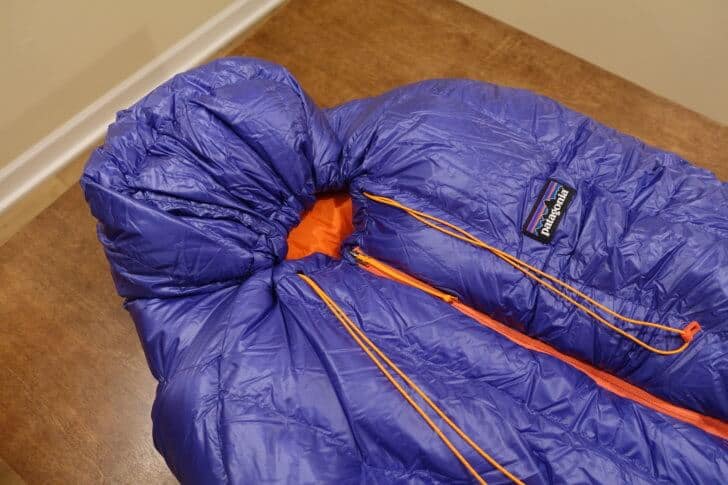


Home › Forums › Patagonia 19 Degree Sleeping Bag Review